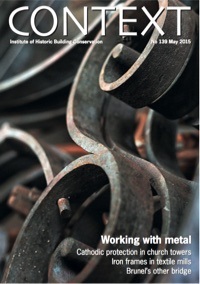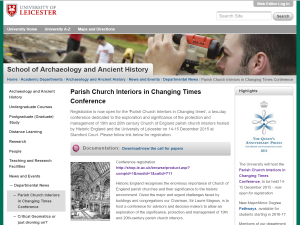 The latest addition to the online archive of the IHBC’s journal Context will appeal to any with a keen interest in materials as it covers ‘working with metal’.
The latest addition to the online archive of the IHBC’s journal Context will appeal to any with a keen interest in materials as it covers ‘working with metal’.
IHBC NewsBlogs author Alison McCandlish said: ‘We all know that building materials themselves, however they are used, contribute hugely to the character of our historic environment, and understanding how to care for them is essential if we are to maintain the structure and appearance of the places we value.’
‘Metal is used in so many ways, from decorative quirky features to cast iron columns that maintain the structural integrity of a building. So IHBC members and colleagues with particular interests in materials will have been especially enthralled with this issue of Context as it explores so many different building types and uses of the metal, right across our IHBC Branches and beyond.’
‘Now, with this issue online, anyone can improve and extend their knowledge of technical conservation and explore historic structures, from the South West of England to the East of Scotland, by learning from articles covering:
- Chris Topp –Wrought Iron, Yesterday And Today
- Richard Baister –Dredges Victoria Bridge
- Geoff Wallis- Brunel’s Other Bridge In Bristol
- David Farrell- Cathodic Protection In Church Towers
- Mark Watson- Iron Frames In Textile Mills
- Jonathan Goode- Aspects Of Copper Roofing
As ever with themed issues we also have the regular features, from our Chair, Director and other regular and occasional contributions, such as news items, book reviews and reports from IHBC officers and members, as well as special articles which in this issue include:
- Justine Page, ‘Going Underground’ to look at the very topical issue of basement extensions in London and
- Justin Webber, on ‘Sweating Heritage Assets’, exploring pro-active Conservation Area management as a way to ease pressure on in-house resources.
Access the newly released issues of Context
If you have any suggestions for articles or other material contact Fiona Newton at: editorial@ihbc.org.uk
Explore our Context online archive
For information on Context’s future issues, guidance for authors, and links to the journal’s archives see the IHBC website


